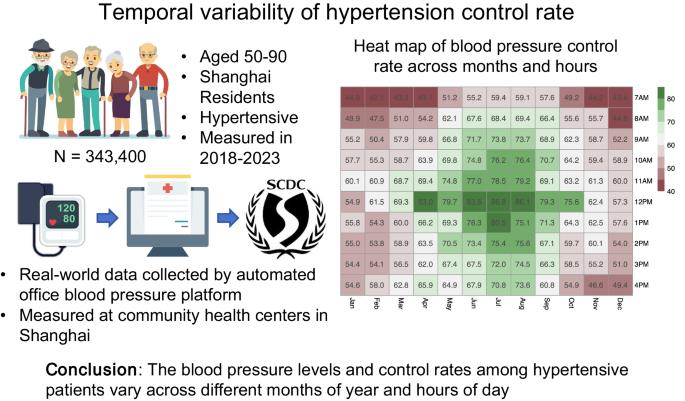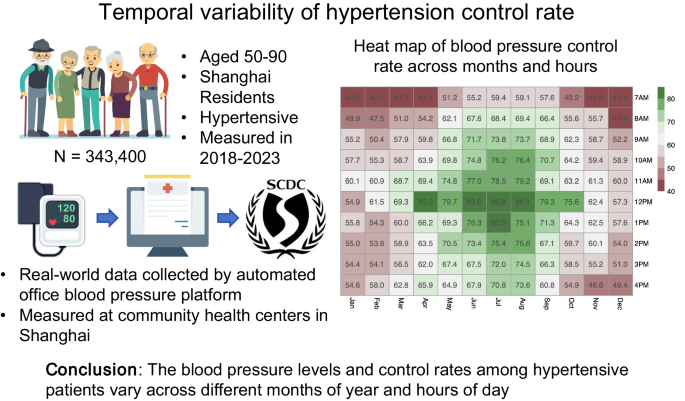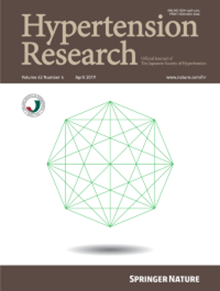The control rate of hypertension across months of year and hours of day in a large real-world database
IF 4.6
2区 医学
Q1 PERIPHERAL VASCULAR DISEASE
引用次数: 0
Abstract
We investigated the control rate of hypertension across months of year and hours of day in a real-world database. The study participants were hypertensive patients from 142 community health centers across 16 districts in Shanghai, China, who measured their blood pressure with an automatic office blood pressure measurement platform between 2018 and 2023. The 343,400 hypertensive patients included 53.7% of women, and had average age of 70.2 (±8.1) years (range 50–90 years). For months of year, the control rate of hypertension was lowest in February and highest in August (51.9% vs 71.8%). For hours of day, the control rate of hypertension was lowest at 7:00 AM and highest at 12:00 PM (52.1% vs 76.0%). When the months of year and hour of day were considered together, the control rate was lowest at 7 AM in February (42.1%), and highest at 12 PM in July (86.8%). In 8516 patients who had uncontrolled blood pressure in the early morning and had their blood pressure also measured around noon, 45.7% had masked uncontrolled morning hypertension, with higher rates in spring and summer, and in women, those aged 50-69 years, and non-diabetic patients. The control rate of hypertension varies greatly across months of year and hours of day, suggesting that the evaluation of blood pressure control has to take into full consideration the measurement time in terms of months and hours.


大型真实世界数据库中不同月份和不同时段的高血压控制率。
我们在真实世界数据库中调查了不同月份和不同时段的高血压控制率。研究对象是来自中国上海 16 个区 142 家社区卫生服务中心的高血压患者,他们在 2018 年至 2023 年期间使用办公室自动血压测量平台测量了血压。34.34万名高血压患者中,女性占53.7%,平均年龄为70.2(±8.1)岁(范围为50-90岁)。就一年中的月份而言,2 月份的高血压控制率最低,8 月份的控制率最高(51.9% 对 71.8%)。就一天中的时间而言,早上 7:00 的高血压控制率最低,中午 12:00 的控制率最高(52.1% vs 76.0%)。如果将一年中的月份和一天中的时间放在一起考虑,2 月份上午 7 点的控制率最低(42.1%),7 月份中午 12 点的控制率最高(86.8%)。在 8516 名清晨血压未受控制并在中午前后测量血压的患者中,45.7% 患有掩盖性清晨血压未受控制的高血压,其中春季和夏季以及女性、50-69 岁人群和非糖尿病患者的血压控制率较高。不同月份和不同时间段的高血压控制率差异很大,这表明在评估血压控制情况时必须充分考虑测量时间的月份和时间。
本文章由计算机程序翻译,如有差异,请以英文原文为准。
求助全文
约1分钟内获得全文
求助全文
来源期刊

Hypertension Research
医学-外周血管病
CiteScore
7.40
自引率
16.70%
发文量
249
审稿时长
3-8 weeks
期刊介绍:
Hypertension Research is the official publication of the Japanese Society of Hypertension. The journal publishes papers reporting original clinical and experimental research that contribute to the advancement of knowledge in the field of hypertension and related cardiovascular diseases. The journal publishes Review Articles, Articles, Correspondence and Comments.
 求助内容:
求助内容: 应助结果提醒方式:
应助结果提醒方式:


